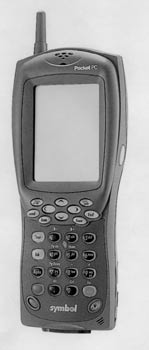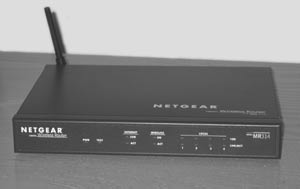Wireless Data Collection Systems
Wireless systems allow portable terminals to transmit and receive information instantaneously from a remote workstation or server. They allow mobility and continuous access to information. Data are always up-to-date, accessible, and can be managed by any user within radio frequency range.
Wireless systems can be simple or complex, depending on the size of the coverage area, the RF environment, the complexity of the bar-code system itself, and the existing computer network. Implementing a wireless system requires a strong knowledge of computer networking protocols, a working understanding of Visual Basic or C++, and knowledge of RF communications. If you don’t have access to programmers and radio technicians inhouse, but absolutely need a wireless system, you will need to hire those experts. Wireless systems are far more expensive than connected or batch systems.
Wireless equipment uses radio waves to communicate with the network. Providing dependable RF system connectivity is not easy in large and complex areas, such as an entire ranger station or a large office building located in an urban setting. When designing a wireless data collection system, you need to address the size of the coverage area, the RF environment, data collection equipment, communication protocols, and integration of the networking components with the bar-code software.
A site survey is usually necessary to determine RF coverage. Many wireless bar-code readers contain a signal-strength utility. You can perform your own site survey by moving throughout the desired coverage area and testing the signal strength.
More access point antennas will be needed to maintain connection to the network for large coverage areas, areas with interfering radio waves, and offices and buildings with numerous interior walls. The range of antennas varies from brand to brand. You may need to place access point antennas in different locations to see which combination of locations provides the best overall coverage. The goal is for your wireless data collection equipment to maintain its connection to the network from any point throughout the site.
The majority of wireless networking equipment uses one of the following four Institute of Electrical and Electronic Engineers (IEEE) transmission standards:
- IEEE 802.11 Data—Rates up to 2 Mbps (million bits per
second) in the 2.4-GHz (gigahertz) band.
- IEEE 802.11a Standard—For WLAN (wide area local area
networks) operations at data rates up to 54 Mbps in the 5-
GHz band.
- IEEE 802.11b Standard—For WLAN operations at data rates
up to 11Mbps in the 2.4-GHz band. (WI-FI).
- IEEE 802.11g Upgrade—For the 802.11b standard, allowing data rates up to 54 Mbps in the 2.4-GHz band, backward compatible with 802.11b equipment.
Even though the IEEE protocols are intended to produce seamless communications between equipment of all types, wireless communication equipment from different manufacturers varies slightly in transmission techniques. Therefore, wireless systems should use equipment from a single manufacturer or with a guarantee of compatibility from the vendor.
Wireless Data Collection Equipment
Portable data terminals and personal digital assistants may be used as wireless data collection equipment. The differences between the two types of devices are narrowing as manufacturers combine features once found on just one of the platforms.
Wireless PDTs share many features with PDTs that must have their data uploaded in batches. They include an operating system, keypad, and memory. A bar-code reader is integrated on some models. An RS232 port is provided for connecting a separate reader to other models. A PDT may be paired with its own receiver or use a separate compatible radio receiver. A wireless PDT may cost two or three times as much as an identical batch version.
PDTs with paired receivers are preconfigured for wireless connection, eliminating worries about compatibility with the receiver. Relay stations may be available to increase the range of coverage. Relay stations usually must be wired to the base station. Some paired-system vendors offer an installation CD that will automatically set up an RS232 serial connection for Windows users. Other systems must be programmed to allow the computer to read and write to the serial port.
Most wireless PDTs do not include a paired receiver, so receivers must be purchased separately. You have a choice among a variety of receivers, from short-range office models to long-range outdoor versions.
Wireless PDTs such as the one shown in figure 15 include an internal radio configured to one of several different protocols. The PDT radio must use the same protocol as the receiver.

Figure 15—The radios in wireless
portable
data terminals are configured
for different
radio frequency
transmission
protocols
]
at the factory.
Wireless PDAs have a built-in radio (figure 16) or an expansion slot that will accept a networking card (figure 17). Accessories are also available to configure a PDA to make it look and feel more like a traditional bar-code reader (figure 18).

Figure 16—This wireless personal
digital
assistant
contains an internal
radio,
freeing
the expansion
slot for a
bar-code
scanning card.

Figure 17—Most personal digital
assistants have
only one expansion
slot. This expansion pack
contains
a
radio, laser scanner, and separate
power pack,
transforming a normal
PDA
into a
wireless bar-code scanning
dynamo.

Figure 18—Using a personal digital assistant to
scan bar codes can
cause hand fatigue.
Handle adapters are available for
many models.
Wireless PDA communication systems use widely available wireless local area network equipment. You will need a compatible RF receiver for the wireless PDA to complete your system. You can use wireless networking cards or access points to communicate with a wireless PDA.
Wireless networking cards (figure 19) are limited to a range of about 50 to 100 feet indoors or 300 feet outdoors. The range varies among cards. They can be used on a single desktop or laptop workstation for RF communication with a PDA. Card systems are a convenient and inexpensive option for small coverage areas such as a chemical storage room.

Figure 19—Personal digital assistants and
some portable
data terminals
can use wireless networking cards, such as
the PCI card shown,
to communicate with
other computers
and networks.
You may need to use access points for extended RF coverage. An access point, such as the one shown in figure 20, is an antenna integrated with hardware and software that provides a link between wired and wireless data transmission and receiving equipment. Access points are usually connected to a wired network or a single workstation by a category 5 cable.

Figure 20—Access points are the preferred method
of establishing
radio frequency coverage.
Both PDT and PDA radios communicate with access points. Your access points and radio should be from the same manufacturer or you should obtain a guarantee of compatibility from the access point vendor.
To extend the coverage area for a RF system, use more linked access points or more powerful antennas (figure 21). Linking access points through a wired network will require additional wiring and may require additional network configuration. Large warehouses, depots, and areas with high RF traffic will probably require multiple access points or an optional antenna that is more powerful than the standard access-point antenna.

Figure 21—Use supplementary antennas to
increase
coverage area or signal strength.
Wireless coverage for several buildings will probably require at least one access point in every building. If you use high-gain antennas, you can cover areas of up to 12 miles in radius without FCC licensing or tower mounts. These systems tend to experience interference in urban areas.
Network and Software Integration
Simple networks can be configured by persons with a basic knowledge of networking protocols using the instructions included with the access point and remote data collector. The resident network support personnel will need to be involved in configuring more complex networks to avoid interference with the existing network.
Once the wired and wireless networks are properly set up, the inventory program and operating system must be programmed to pass data back and forth between the host computer and the remote data collector, and to allow data to be managed from the remote source. Configuring the main data storage program to interact with the remote data collection system requires competency in Visual Basic or C++.
Most radio and remote data collector manufacturers offer free software development kits (SDKs) for modern operating systems such as Windows 2000 and Windows XP. These SDKs greatly ease the process of programming. Resourceful programmers may find free sample programming code for their applications from developer’s forums available on the Internet.
Recently, expensive new software has been developed to reduce or eliminate configuration programming. Because of the enormity of possible equipment and software combinations, these programs can be used successfully only by those with excellent computer skills. In the future these programs will become easier to use and less costly.

